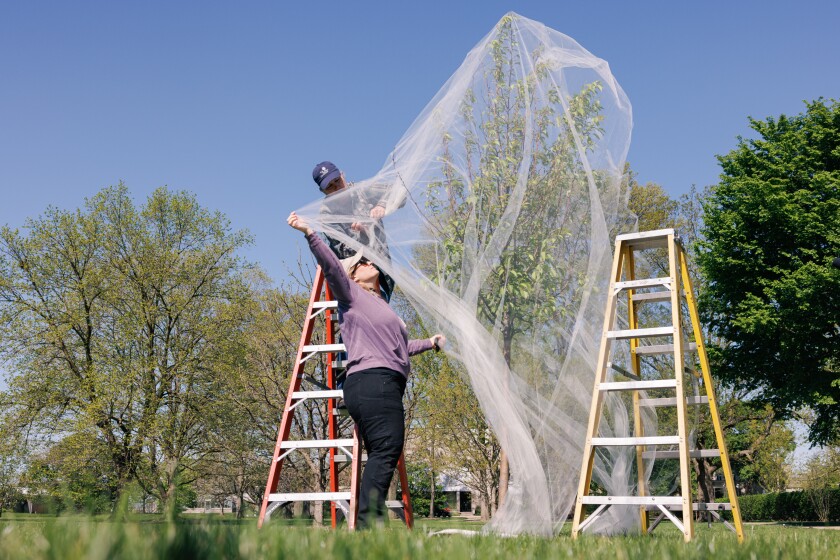Periodical cicadas are starting to emerge in northern Illinois for the first time in 17 years, and while they’re harmless to humans, they can be detrimental to young trees.
As the cicadas come out from underground this spring, they’ll mate and lay eggs over the next several weeks. Female cicadas lay eggs in tree branches, and young and vulnerable trees are at risk if not properly protected with fine netting.
It’s important to protect any trees planted in the past two or three years, according to experts at the Morton Arboretum, who demonstrated proper tree netting Tuesday in Lisle.
“Protect any tree you cannot stand to lose,” said Spencer Campbell, manager of the arboretum’s plant clinic. “It’s cheaper to protect your tree than replace it.”
About 500 trees at the arboretum will have the protective netting on them this spring.
Older trees with a trunk wider than 2 inches won’t be at risk of lasting consequences of the cicada emergence, and any tree older than 17 years has been through this before, Campbell said.
Maples, oaks and willows are among the cicadas’ preferred hosts. They tend to avoid conifer trees. The arboretum’s website has a full list of preferred hosts.
The best way to protect young trees is with fine mesh netting, like tulle or any standard insect netting. The netting shouldn’t have spaces of more than a quarter-inch wide to keep the cicadas out, Campbell said.
Morton Arboretum horticulturists Rachel White and Rachelle Frosch demonstrated how to protect a crab apple tree and tupelo tree, by draping the netting over each while using a long stick to guide the material.
Once draped, they twisted the edges together and stapled them to create a seal resistant to cicadas looking for a place to lay their eggs.
They then secured the netting at the base where branches sprout from the trunk, leaving the branches in a protective bubble.
Cicadas typically get to branches by climbing up the trunk, so securing the netting below the bottom branches is enough to keep them away from vulnerable parts of a tree.
“You want to use a material that breathes really nicely so it doesn’t trap excess moisture,” said Stephanie Adams, the arboretum’s plant health care leader.
Using the wrong material — one that’s not as breathable or doesn’t let in light — could harm the tree, Campbell said.
This spring is historic for cicada emergence in the U.S., as two broods, or breeding groups, are coming out from underground at the same time. One brood emerges every 17 years, and the other reveals itself every 13 years. This year, they’re both beginning to emerge, and experts expect billions of the insects across Illinois.
The periodical cicadas are different from the annual cicadas that emerge later in the summer. Those cicadas don’t pose long-term threats to trees, Campbell said.
The arboretum staff recommends netting trees as soon as possible and leaving the nets up for about six weeks.









